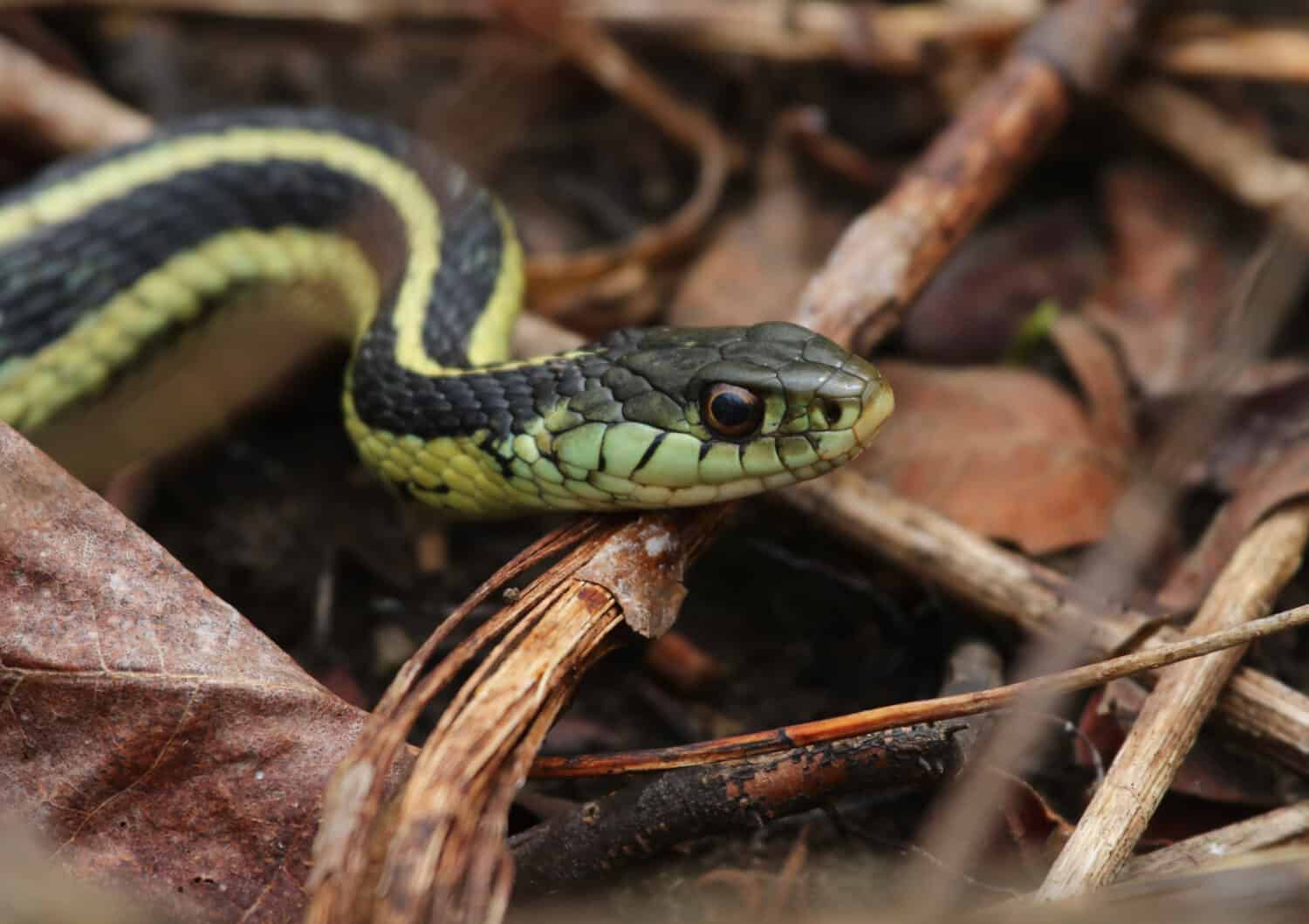Do you avoid snakes like the plague? Then you’ll want to be aware of these four most snake-infested lakes in Massachusetts. Of course, whether a place is snake-infested is largely up to interpretation. So, with the help of iNaturalist.org, we’ve located the four lakes you’re likely to run afoul of the largest quantity of these legless rodent exterminators.
With around 3,000 reservoirs, lakes, and ponds in the Bay State, there’s a solid chance that you’ll spot a few snakes slithering around Massachusetts’ lakes. However, because Massachusetts is further north than other states there aren’t as many snake species to find.

Northern Watersnakes in Massachusetts Lakes
There’s only one water snake native to Massachusetts and it is common across the state, in freshwater with enough food and shelter. The common or northern water snake (Nerodia sipedon) inhabits many of Massachusetts’ lakes. You’ll find it cruising along the edges of lakes, looking for small fish, frogs, tadpoles, and other prey items. Common water snakes also eat small mammals, crayfish, and other things they can catch.
Northern watersnakes are, by far, the species you’re most likely to see in and around Massachusetts’ lakes. They’re extremely common throughout the state and thrive in the habitats lakes provide. These snakes are not mild-mannered like rat snakes, nor do they enjoy being picked up by people. Instead, picking up a northern watersnake means that you’re going to be bit and probably musked on too. Fortunately, they’re not venomous. So, the only thing you’ll walk away with after a watersnake encounter is a few new cuts and a desperate need to thoroughly wash off the stench.
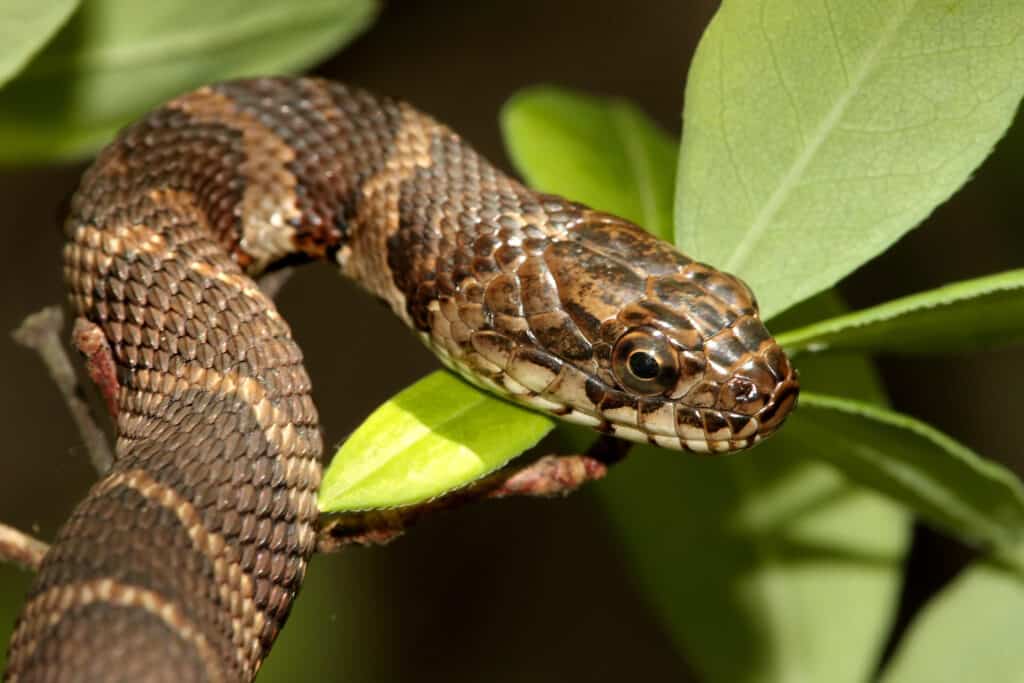
Northern watersnakes are the only native Massachusetts water snake species.
©Steve Byland/Shutterstock.com
1. Quabbin Reservoir
This is our number one snake-infested lake in Massachusetts. Partly, it’s huge — as the biggest inland body of water in the state, Quabbin Reservoir even has a small island in the middle. Which, until public complaints stopped the plan in 2017, was going to be the location of the timber rattlesnake colony.
Quabbin Reservoir is home to almost all of Massachusetts’s 14 snake species. You could spot ring-necked and red-bellied snakes, eastern milksnakes, and maybe even a racer. However, the most common snakes are northern watersnakes and eastern garter snakes.

A view over the Quabbin Reservoir in Massachusetts.
©Belia Koziak/Shutterstock.com
2. Two Small Lakes at Great Meadows National Wildlife Refuge
These ponds are drained into the Concord River every summer and form the heart of the refuge. When the original owner, D. Samuel Hoar was the original owner and he created small earthen dams to trap some of the water in the wetlands for additional habitat for waterfowl — for hunting. However, in 1944, he donated it to the U.S. Government for use as a wildlife refuge.
Now, it’s home to hundreds of species including the ever-present northern watersnake, eastern garter snake, and eastern milksnake.
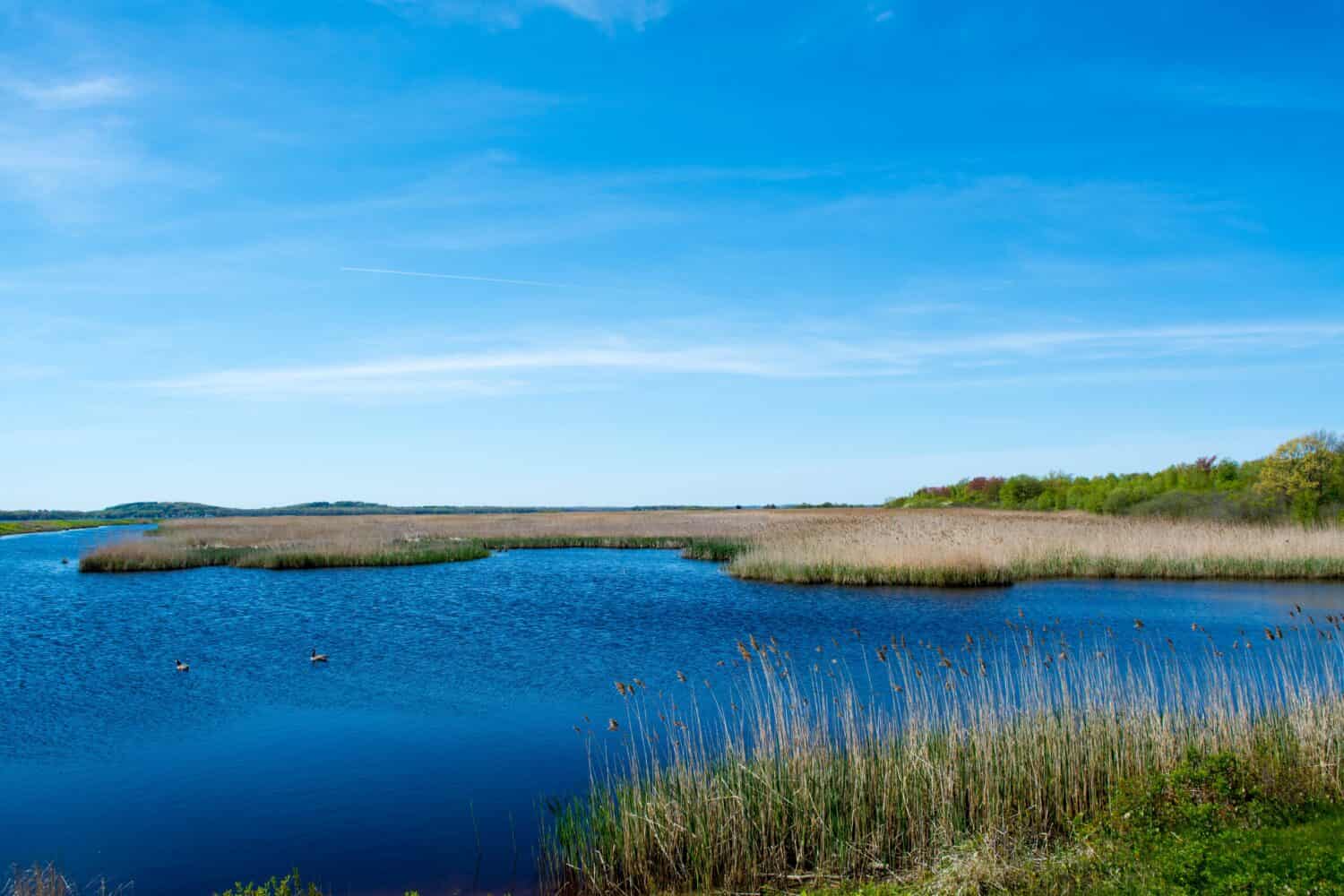
Great Meadows National Wildlife Refuge is home to hundreds of species of snakes.
©Brandon B/Shutterstock.com
3. Wachusett Reservoir
In central Massachusetts, the Wachusett Reservoir is part of the water supply system for three million people. So, the Massachusetts Department of Conservation and Recreation strictly limits public use to hiking, fishing, hunting, and during the winter, snowshoeing, and cross-country skiing.
Although the limitations may be a bit sad if you love boating and swimming, this is fantastic for wildlife, because it limits the of impact human activities. If you wander around the edges of the reservoir, northern watersnakes, and garter snakes are the most common, but eastern milk snakes and Dekay’s brownsnakes also lurk in the brushes and leaf litter.

Wachusett Reservoir in Massachusetts is off-limits to human swimming, but there are snakes!
©iStock.com/carpere
4. Spot Pond
This “pond” is big enough for boating and fishing, along with numerous land-based activities like hiking and camping. Spot pond was used by shoe and rubber factories for the water supply, but is now an outdoor attraction for locals and tourists.
It’s got a decent snake population too — with several miles of coastline, you’ll find garter snakes, common water snakes, eastern milksnakes, Dekay’s brownsnake, and red-bellied snakes during the warmer months.
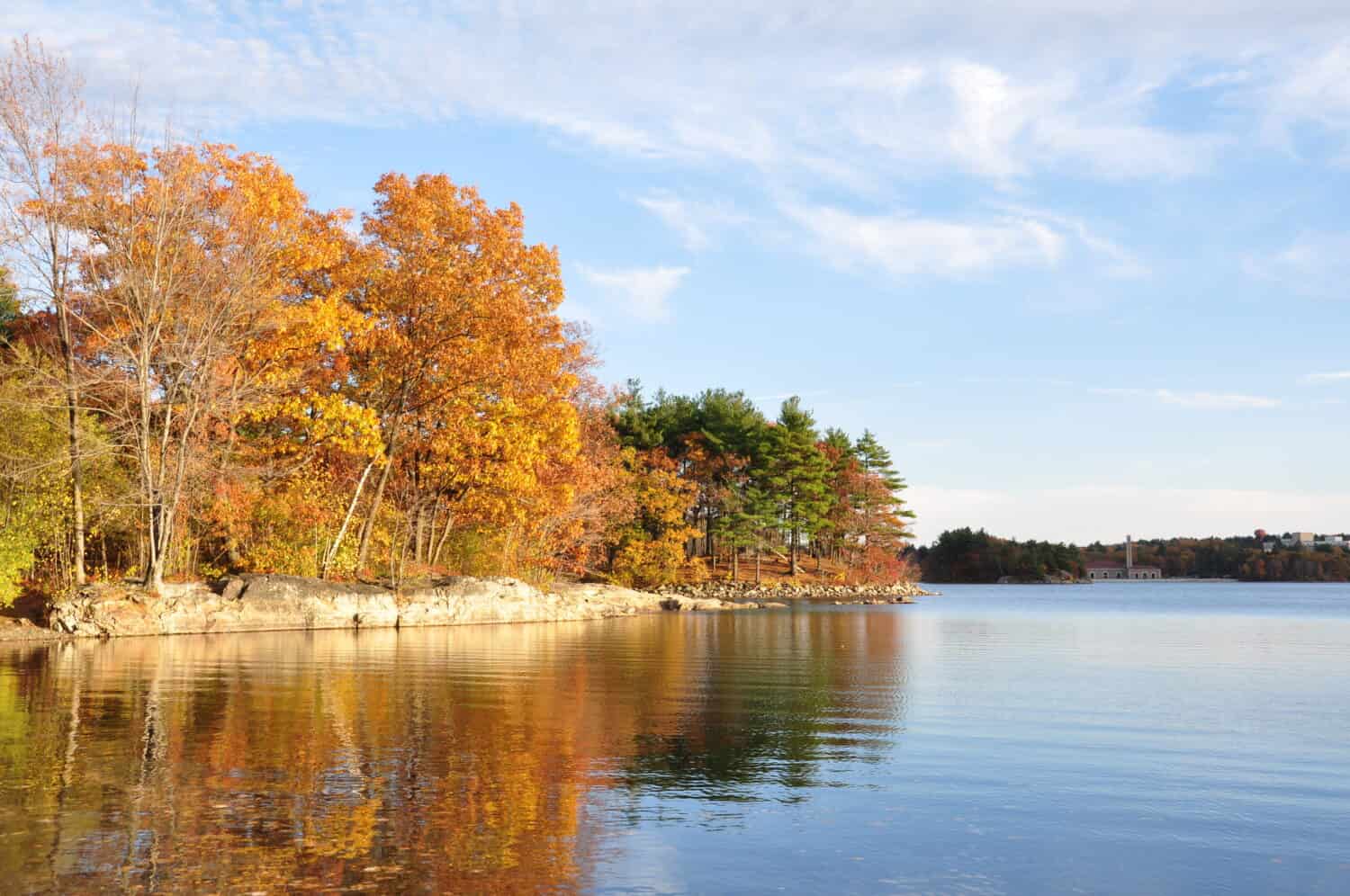
Spot Pond in Massachusetts is popular for people and snakes.
©Sasha Fenix/Shutterstock.com
About Massachusetts’ Water Supply
You probably noticed that Massachusetts strictly regulates the use of its reservoirs. Around many reservoir trails and parks, your pet dog can’t even go with you. They regulate the use because, instead of relying on filtration for most of their water health, they rely on protecting the water supply itself. So, things like boating and swimming generally aren’t allowed.
Summary of the Most Snake-Infested Lakes in Massachusetts
| Lake Name | Snakes Found | |
|---|---|---|
| 1. | Quabbin Reservoir | Northern watersnakes, eastern garter snakes, red-bellied snakes, Dekay’s brownsnakes, eastern milksnakes, maybe a copperhead. |
| 2. | Great Meadows National Wildlife Reserve Lakes | Northern watersnakes, eastern garter snakes, red-bellied snakes, Dekay’s brownsnakes, eastern milksnakes, maybe a copperhead. |
| 3. | Wachusett Reservoir | Northern watersnake, eastern garter snake, Dekay’s brownsnake |
| 4. | Spot Pond | Garter snakes, common water snakes, eastern milksnakes, Dekay’s brownsnake, and red-bellied snakes |
Complete List of Massachusetts Snakes
- Black Racer (Coluber constrictor) — relatively common, but they take off at the first sign of a human, so you may not see one.
- Black Rat Snake (Pantherophis alleghaniensis) — not very common in the state, there’s only a finger of their range present.
- Dekay’s Brown Snake (Storeria dekayi) — hard to say, they’re relatively common but their reclusive nature makes them sometimes harder to spot.
- Copperhead (Agkistrodon contortrix) — rare and only present in a couple of pockets in Massachusetts.
- Common Garter Snake (Thamnophis sirtalis ssp.) — usually it’s the eastern garter snake, but these subspecies are often difficult to identify accurately.
- Eastern Hognose Snake (Heterodon platirhinos) — not as common as we’d like! They’re most likely found around the edges of water sources where there’s sandy soil to burrow into.
- Eastern Ribbon Snake (Thamnophis sauritus) — relatively common in most areas, but people often confuse them for garter snakes.
- Milk Snake (Lampropeltis triangulum) — not hard to find. At all.
- Northern Water Snake (Nerodia sipedon) — found in most water bodies in Massachusetts.
- Red-bellied Snake (Storeria occipitomaculata) — similar to Dekay’s brownsnake. Probably more common than we realize.
- Ringneck Snake(Diadophis punctatus) — really neat little harmless snakes that hide under rotten logs and leaf litter.
- Smooth Green Snake (Opheodrys vernalis) — green snakes blend into the vegetation so well that you may miss one staring right at you.
- Timber Rattlesnake (Crotalus horridus) — extremely rare.
- Worm Snake (Carphophis amoenus) — they spend most of their time underground, so we don’t see them frequently.
Other Animals Found Near Lakes in Massachusetts
At least 800 animal species call Massachusetts home. Everything from moose and black bears to bats, birds, and weasels can be found somewhere within the state’s borders. Here are a few:
Eastern Red-Backed Salamander (Plethodon cinereus)
One of the most common salamanders in its range, the eastern red-backed salamander averages between two and four inches long from snout to tail. It lives under moist leaf litter, rotten logs, and anywhere there’s enough moisture for it to be able to breathe. That’s because this salamander doesn’t have lungs. Its only option for breathing is through its permeable skin.

Red-backed salamanders don’t have lungs and breathe through their skin.
Image: Danita Delimont, Shutterstock
©Danita Delimont/Shutterstock.com
American Beaver (Castor canadensis)
The biggest rodent in North America, the American beaver can weigh up to 70 pounds but their average weight is around 44. Possibly best known for chewing up trees and building dams and lodges in ponds, lakes, and rivers, beavers are either the second or third-largest rodent in the world after the capybara and the Eurasian beaver.
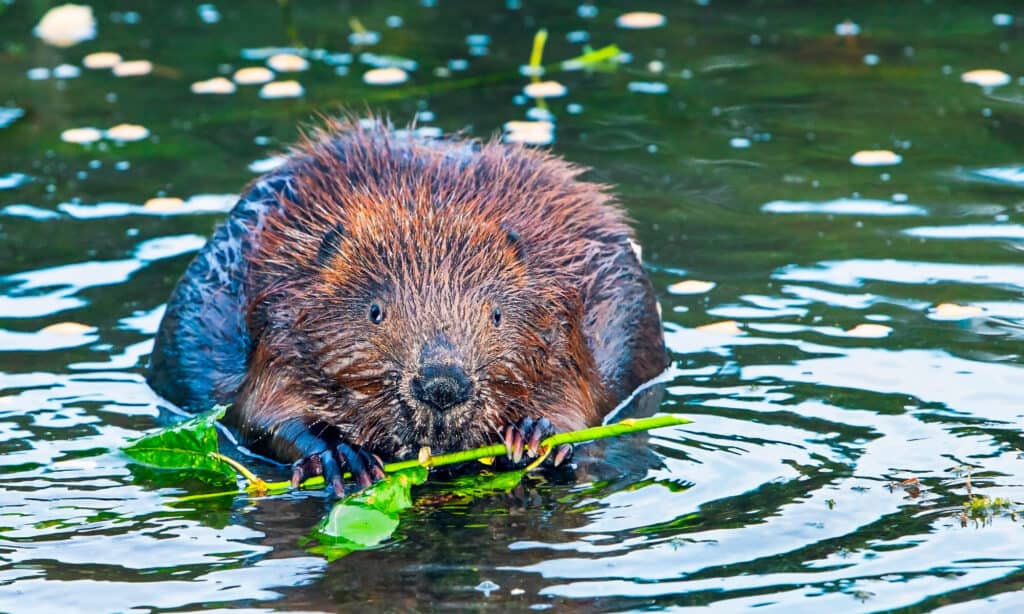
Beavers create dams and lodges by chewing through small saplings for wood and mud and grass for strength.
©SERGEI BRIK/Shutterstock.com
Barred Owl (Strix varia)
In Massachusetts, barred owls are common. They’re native to the eastern half of the United States, but they’ve also expanded their range all the way to the Pacific coast. Their expanded range is causing problems with local animals, so experts are recommending culling some from areas where they didn’t historically live.
These are big owls, with wingspans that vary from three to four feet. And, like other owls are nocturnal hunters with excellent night vision.

Barred owl
, Strix varia, perched on a branch in winter in Canada.
©Jim Cumming/Shutterstock.com
Thank you for reading! Have some feedback for us? Contact the AZ Animals editorial team.

